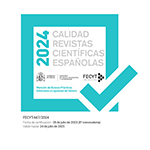The Challenges of Digital Education in Adolescents with Specific Educational Support Needs. Case study
Abstract
Information and Communication Technologies have acquired a leading role in our day to day since they provide greater access to information. On the contrary, digitalization does not apply equally throughout the world or in all sectors of the population, generating an imbalance known as the digital divide. This technological discrimination becomes more significant in the most vulnerable sectors of society such as adolescents with disabilities, depriving them of essential resources to develop and integrate actively into the community. For this reason, a qualitative study was conducted through scripted interviews with students of the I.E.S Rute de la Plata in Calamonte (Badajoz).
The results of this work make visible the need for students and teachers to receive more training on digital tools and the use of ICT in the classroom. In the first case, to obtain more and better professional opportunities and minimize the impacts of the digital divide, and in the second, to improve the teaching-learning process. Finally, the contributions of this research aim to shed light on the digital and educational actions to be followed with the adolescent group to promote their digital citizenship.
Downloads
Article download
License
In order to support the global exchange of knowledge, the journal Sociedad e Infancias is allowing unrestricted access to its content as from its publication in this electronic edition, and as such it is an open-access journal. The originals published in this journal are the property of the Complutense University of Madrid and any reproduction thereof in full or in part must cite the source. All content is distributed under a Creative Commons Attribution 4.0 use and distribution licence (CC BY 4.0). This circumstance must be expressly stated in these terms where necessary. You can view the summary and the complete legal text of the licence.










